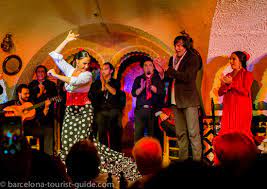The traditional dance of flamenco originated from southern Spain and incorporates music and meaningful moves of the body. A combination of cante (singing), toque (guitar playing), baile (moving), and jaleo alludes to the vocalizations and musical hints of palm (handclapping) and pitos (finger snapping). It is considered to be a symbol of Spanish identity and has been listed as an intangible cultural heritage by UNESCO.

Catalonia is home to a thriving flamenco scene, having developed its own unique variation of flamenco known as “Catalan flamenco.” One of the defining characteristics of Catalan flamenco is its use of the cajón, a wooden box percussion instrument that has African roots. The cajón adds a different rhythmic element to the dance and helps to distinguish Catalan flamenco from other forms of the dance. Additionally, Catalan flamenco is known for its use of the tambourine, a small handheld drum with cymbals. Also, it incorporates modern elements in costume designs, which often feature bright colours and bold patterns, as well as the use of modern music and dance techniques.
If you’re intrigued by this traditional dance and its disruptive rhythms and you find yourself in the vibrant city of Barcelona, you should definitely dedicate one evening to the discovering of this art in the typical venues – called tablaos – that host flamenco shows. Since the quality of the performances in Catalan tablaos is high, we heartly suggest to book your tickets well in advance.
One of the most famous venues is Palau de la Música Catalana, a stunning modernist concert hall that was built in the early 20th century. Here, audiences can enjoy traditional flamenco performances, as well as more contemporary styles that incorporate elements of hip-hop, jazz, and other musical genres.

One of the most traditional and well-known tablaos is the Tablao Cordobes in the heart of Barcelona. With its stunning decor and intimate atmosphere, it offers an immersive experience that is not to be missed. Tablao de Carmen in the Gothic Quarter is another valuable option, its design reminds of the traditional style of Andalusian courtyards, complete with intricate tile work and elegant arches.
Whether you’re a flamenco enthusiast or just looking for a new and exciting cultural experience, Catalan flamenco is definitely worth checking out. For those interested in learning more about Catalan flamenco, there are a number of workshops and classes available in Barcelona. But if you are interested in private lessons, possibly in the comfort of one’s villa, Catalunya Casas can arrange a lesson of flamenco for you during your stay.
Join us in our Flamenco lessons!






